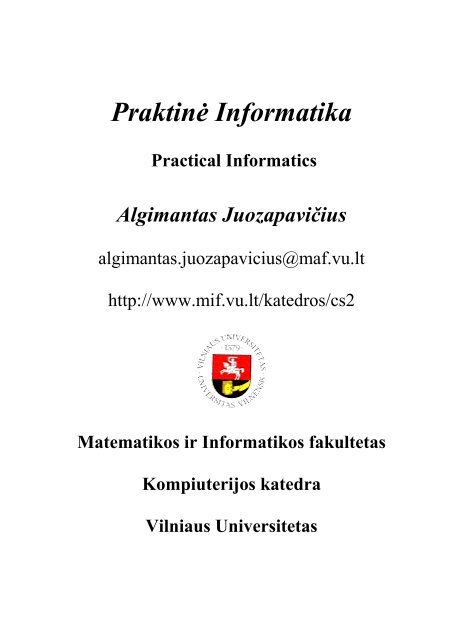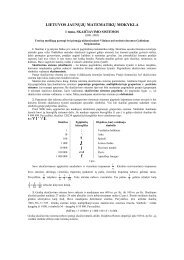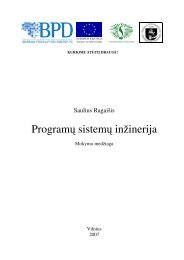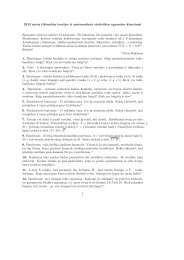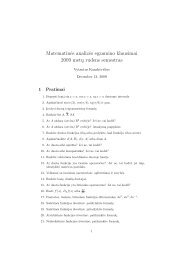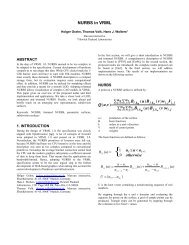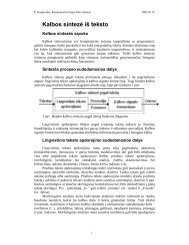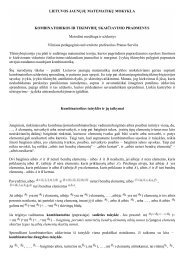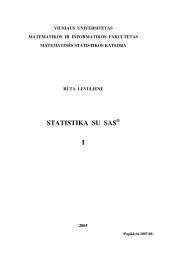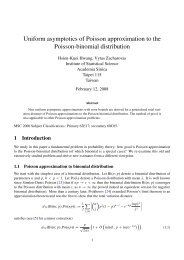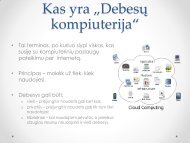PraktinÄ Informatika - Matematikos ir Informatikos fakultetas ...
PraktinÄ Informatika - Matematikos ir Informatikos fakultetas ...
PraktinÄ Informatika - Matematikos ir Informatikos fakultetas ...
Create successful ePaper yourself
Turn your PDF publications into a flip-book with our unique Google optimized e-Paper software.
Praktinė <strong>Informatika</strong>Practical InformaticsAlgimantas Juozapavičiusalgimantas.juozapavicius@maf.vu.lthttp://www.mif.vu.lt/katedros/cs2<strong>Matematikos</strong> <strong>ir</strong> <strong>Informatikos</strong> <strong>fakultetas</strong>Kompiuterijos katedraVilniaus Universitetas
Praktinė <strong>Informatika</strong>Praktinė informatika apima bazines žinias, kurių reikia studentamsd<strong>ir</strong>bant su kompiuteriu:• ergonominiai principai,• operacinės sistemos <strong>ir</strong> jų teikiamas vartotojo interfeisas,• įva<strong>ir</strong>ios pask<strong>ir</strong>ties programos ar kalbos (Word, Excel, PowerPoint,Access, Latex, Html, Matlab, Maple, Delphi, Java)Šis kursas turi išmokyti studentus:• įsisavinti kompiuterinę terminologiją,• rengti sudėtingesnio turinio dokumentus,• naudoti kompiuterį pvz. “matematinės analizės” kurse, skaičiuotikompiuteriu įva<strong>ir</strong>iarūšes (išreikštines) formules, analizuoti jas,vizualizuoti jų grafikus, pav<strong>ir</strong>šius,• kurti Interneto tinklapius,• rengti leidybai tinkamus kokybiškus tekstus <strong>ir</strong> tekstus su formulėmis,• rengti įva<strong>ir</strong>ias lenteles, manipuliuoti su jomis, organizuoti duomenisjose, atlikti paieškos operacijas.Kursas apima:• teorines paskaitas,• praktines užduotis arba projektus (vykdomus ar aptariamus pratybųmetu)Atsiskaitymo forma: įskaita (įskaita pas<strong>ir</strong>ašoma, kai apginamos visosužduotys ar projektai)Literatūra:• Gintautas Garšva, Microsoft Windows Word 6.0 <strong>ir</strong> 7.0, Vilniausuniversiteto leidykla, 1996.• R.Valatkaitė, Z.Kud<strong>ir</strong>ka, Lietuvių-anglų-rusų-vokiečių terminųžodynas INFORMATIKA, red. ISBN 9986-680-05-0, <strong>Matematikos</strong> <strong>ir</strong>informatikos institutas, Vilnius, 1999• K.V.Paulauskas, R.Jasinevičius. Aiškinamasis kompiuterijos žodynas.Technologija, Kaunas, 1995• G. Misevičius, A. Pincevičius, R. Rakauskas, R. Eidukevičius.Aukštoji matematika, TEV, Vilnius, 1999Kursui klausyti reikalingos žinios: specialių reikalavimų nėra
Kurso turinys1-as semestras• bendri darbo su kompiuteriu principai, ergonomiškumas,techniniai, socialiniai, psichologiniai, kiti susiję aspektai,• kompiuterių funkcionavimo principai <strong>ir</strong> schemos, operacinėssistemos, programinė kompiuterių įranga, taikomoji programinėįranga, jos klasifikacija <strong>ir</strong> apžvalga,• tekstiniai redaktoriai, dokumento struktūra <strong>ir</strong> sudėtinės dalys,operacijos su jomis,• programinė sistema MicroSoft Word, jos pagrindiniai darboprincipai, komandos, procedūros, šablonai, darbo su šiaprogramine sistema organizavimas,• matematinės formulės, jų skaičiavimai kompiuterių pagalba,simboliniai <strong>ir</strong> skaitmeniniai skaičiavimai,• matematinių skaičiavimų sistemos MATLAB <strong>ir</strong>/arba MAPLE,darbas su jomis, ypatybės, formulių grafikų vizualizacija,• Internetas, publikavimo procedūros Internete,• internetinių tinklapių <strong>ir</strong> svetainių projektavimas, kūrimas,diegimas, kalba HTML, HTML-dokumentų redaktoriai,• vaizdų dėstymas internetinėse svetainėse, rastrinės grafikosredaktoriai, programa Photo Editor,• elektroninio publikavimo reiškinys, sudėtingesnių leidiniųrengimas,• elektroninė leidybinė sistema LATEX, dokumento formavimo jospagalba principai, jos veikimas,
Impacts of Information Technologyon Individuals and SocietyInformation systems affect individuals in various ways. What is abenefit to one individual may be a curse to another. Some of the waysthat IT may affect individuals, the<strong>ir</strong> perceptions and behaviors, will beconsidered next.Job satisfactionAlthough many jobs may become substantially more "enriched"with IT, other jobs may become more routine and less satisfying.For example, some analysts predicted that computer-basedinformation systems would reduce managerial discretion indecision making and thus create dissatisfied managers.DehumanizationA frequent criticism of traditional data processing systems is the<strong>ir</strong>negative effect on people's individuality. Such systems arecriticized as being impersonal; they dehumanize and depersonalizeactivities that have been computerized. Many people feel a loss ofidentity; they feel like "just another number" because computersreduce or eliminate the human element that was present in thenoncomputerized systems.While the major objective of new IT technologies such asDecision-Support-Systems is to increase productivity, they alsocreate flexible systems that can allow individuals to input the<strong>ir</strong>opinions and knowledge. These technologies attempt to be peopleoriented arid user friendly.One can pose the question of“whether IT exists for the sake of people or whether people existfor the sake of the technology”.This means the importance of achieving a balance between technologyand the significance of the person in an organization.
Just another question“whether IT is just one organizational function or whether theorganization is a function of IT”.Technical solutions to organizational problems can easily subvert theneed to consider relationships among people in an organization.The basic requ<strong>ir</strong>ement for system development is the recognition that allwork processes be designed because of people and for people.Hardware and software accomplish many difficult tasks previouslyperformed by people. This enables people to devote time to morecreative tasks.Now, however, Executive Information Systems and ArtificialIntelligence are replacing people in the creative arena. People havebecome dependent on technology and may become a mere link in thechain.One faces a half-serious yet worrying question:“will there be any place for man in the future automated world?”Psychological impactsOne example of a psychological impact resulting from thewidespread use of home computers is that home computersthreaten to have an even more isolating influence than was createdby television. If people are encouraged to work and shop fromthe<strong>ir</strong> living rooms, then some unfortunate psychological effects –such as depression and loneliness-could develop.Another example is distance learning. Children can be schooled athome through IT, but the lack of social contact could be damaging.
Repetitive Strain InjuriesExposure to video display terminals (VDTs) raised the issue of risk ofradiation exposure, which has been linked to cancer and other healthrelatedproblems:for example, lengthy exposure to VDTs has been blamed formiscarriages in pregnant women.However, results of the research done to investigate this charge havebeen inconclusive.It is known:• that exposure to VDTs for long periods of time can affect anindividual's eyesight;• other potential hazards, though not d<strong>ir</strong>ect results of the VDT, arebackaches due to long or inappropriate sitting in front of computersand muscle tension in peoples' fingers and wrists.Carpal tunnel syndrome is a pernicious and painful form of repetitivestrain injury that affects the wrists and hands – it has been associatedwith the long-term use of the keyboard.Repetitive strain injuries can be very costly to corporations. Since 1994,there have been more than 2,000 lawsuits against computermanufacturers and employers.For example, a lawsuit against IBM filed in 1994 requested $11.5million for inappropriate design of a keyboard that caused carpal tunnelsyndrome.Essening The Negative Impact On Ealth And SafetyDesigners are aware of the potential problems associated with prolongeduse of computers. Consequently, they have attempted to design a bettercomputing env<strong>ir</strong>onment.Research in the area of ergonomics (or human factors) providesguidance for designers. For instance, ergonomic techniques focus oncreating an env<strong>ir</strong>onment for the worker that is well lit and comfortable.
Other ImpactsIndividuals can be affected by computerization in many ways. Actually,computers change the manner in which people live, work, learn, andentertain themselves.Interaction between individuals and computers are so numerous thatent<strong>ir</strong>e volumes have been written on the subject.The figure below shows the individual c<strong>ir</strong>cled by electronic transfer ofmoney (to be used in home shopping and smart cards) that allowspurchase of products and services. These are organized in theintermediate ring as six systems (consumer, education, and so on).Finally, the outer ring gives some examples of specific products orservices in each system:SOCIETAL IMPACTSThe societal implications of IT will be far reaching. Use of IT alreadyhas had many d<strong>ir</strong>ect beneficial effects on society – solving complicatedhuman and social problems such as medical diagnosis, computerassistedinstruction, government program planning, env<strong>ir</strong>onmentalquality control, and law enforcement.
Problems in these areas could not have been solved economically-or atall-without IT.Opportunities For People With DisabilitiesAdaptive equipment permits people with disabilities to perform ordinarytasks with computers. In figure below one can see a PC for a motordisabledperson:Changing Role Of WomenIT is changing the "traditional" role of women in the workplace. Theopportunity to work at home helps women with young children assumemore responsible managerial positions in organizations.This could lead to better pay for women who can devote more attentionto business while they still carry on duties at home.Improvements In Health CareEMERGING TECHNOLOGY:Expert systems help individuals to be healthier and wealthierIT has caused major improvements in health care delivery ranging frombetter and faster diagnoses to expedited research and development ofnew drugs, to more accurate monitoring of critically ill patients.
One technology that has made a special contribution is artificialintelligence. Al supports various tasks carried out by physicians andother health-care workers. Of special interest are expert systems thatsupport diagnosis of diseases and the use of machine vision in enhancingthe work of radiologists. Recently, surgeons started to use v<strong>ir</strong>tual realityto plan complex surgeries.Help For The ConsumerSeveral IT products are in place, and many more will be developed, tohelp the layperson perform tasks that are skilled or tasks that areundes<strong>ir</strong>able. TaxCut is an expert system product that can help in taxpreparation; Willmaster is an ES that helps a layperson draft a simplewill; and Wines on Disk advises the consumer how to select wines.Intelligent robots will clean the house and mow the lawn. These andmany other improvements can contribute to an increased quality of life.QUALITY OF LIFEOn a broader scale, IT has implications for the quality of life. Anincrease in organizational efficiency may result in more leisure time forworkers.The workplace can be expanded from the traditional nine-to-fivejob at a central location to twenty-four hours-a-day at any location.This expansion provides a flexibility that can significantly improve thequality of leisure time, even if the total amount of leisure time is notincreased. Our health and safety can also be improved, since robots canwork in uncomfortable or dangerous env<strong>ir</strong>onments.


